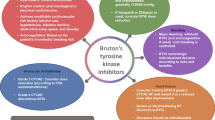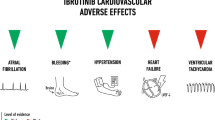Abstract
Purpose of Review
The identification of BRAF mutation prompted the development of new class of targeted therapy for treating melanoma: BRAF inhibitors and MEK inhibitors. Cardiovascular events have been reported with these treatments and could counterbalance their long-term maintenance.
Recent Findings
LVEF decrease due to BRAF and MEK inhibitors appears fairly common (10%) but usually not severe, without impact on patient outcomes. To date, no treatment options have been tested to prevent or to treat a decrease of LVEF associated with BRAF and MEK inhibitors. QTc prolongation was observed in 3% and arterial hypertension in 20% during treatment but only one-third of cases required a therapeutic change.
Summary
BRAF and MEK inhibitors have revolutionized the management and the prognosis of melanoma patients. Cardio-oncology units may be useful for a better care of potential cardiac toxicity and particularly to inappropriately avoid discontinuing BRAF and MEK inhibitors.

Similar content being viewed by others
References
Papers of particular interest, published recently, have been highlighted as: • Of importance •• Of major importance
Siegel RL, Miller KD, Fuchs HE, Jemal A. Cancer Statistics, 2021. CA Cancer J Clin. 2021;71(1):7–33. https://doi.org/10.3322/caac.21654.
Subbiah V, Baik C, Kirkwood JM. Clinical development of BRAF plus MEK inhibitor combinations. Trends Cancer. 2020;6(9):797–810. https://doi.org/10.1016/j.trecan.2020.05.009.
Solares I, Viñal D, Morales-Conejo M, Rodriguez-Salas N, Feliu J. Novel molecular targeted therapies for patients with neurofibromatosis type 1 with inoperable plexiform neurofibromas: a comprehensive review. ESMO Open. 2021;6(4): 100223. https://doi.org/10.1016/j.esmoop.2021.100223.
Banks M, Crowell K, Proctor A, Jensen BC. Cardiovascular effects of the MEK inhibitor, trametinib: a case report, literature review, and consideration of mechanism. Cardiovasc Toxicol. 2017;17(4):487–93. https://doi.org/10.1007/s12012-017-9425-z.
National Cancer Institute Common Terminology Criteria for Adverse Events (CTCAE). https://www.eortc.be/services/doc/ctc/CTCAE_4.03_2010-06-14_QuickReference_5x7.pdf. Accessed July 5, 2019.
Bueno OF, Molkentin JD. Involvement of extracellular signal-regulated kinases 1/2 in cardiac hypertrophy and cell death. Circ Res. 2002;91(9):776–81. https://doi.org/10.1161/01.res.0000038488.38975.1a.
Lips D, Bueno O, Wilkins B, Purcell N, Kaiser R, Lorenz J. MEK1-ERK2 signaling pathway protects myocardium from ischemic injury in vivo. Circulation. 2004;109(16):1938–41.
Purcell NH, Wilkins BJ, York A, et al. Genetic inhibition of cardiac ERK1/2 promotes stress-induced apoptosis and heart failure but has no effect on hypertrophy in vivo. Proc Natl Acad Sci U S A. 2007;104(35):14074–9. https://doi.org/10.1073/pnas.0610906104.
Daud A, Tsai K. Management of treatment-related adverse events with agents targeting the MAPK pathway in patients with metastatic melanoma. The Oncologist. 2017;22(7):823–33. https://doi.org/10.1634/theoncologist.2016-0456. Interesting review describing all side effects observed in patients treated with BRAF and MEK inhibitors for melanoma.
Dummer R, Ascierto PA, Gogas HJ, et al. Overall survival in patients with BRAF-mutant melanoma receiving encorafenib plus binimetinib versus vemurafenib or encorafenib (COLUMBUS): a multicentre, open-label, randomised, phase 3 trial. Lancet Oncol. 2018;19(10):1315–27. https://doi.org/10.1016/S1470-2045(18)30497-2.
Ascierto PA, McArthur GA, Dréno B, et al. Cobimetinib combined with vemurafenib in advanced BRAF(V600)-mutant melanoma (coBRIM): updated efficacy results from a randomised, double-blind, phase 3 trial. Lancet Oncol. 2016;17(9):1248–60. https://doi.org/10.1016/S1470-2045(16)30122-X.
Mincu RI, Mahabadi AA, Michel L, et al. Cardiovascular adverse events associated with BRAF and MEK inhibitors. JAMA Netw Open. 2019;2(8). https://doi.org/10.1001/jamanetworkopen.2019.8890. This study summarized the frequency of cardiac toxicity with BRAF and MEK inhibitors observed in all randomized controlled trial for treating melanoma patients.
Berger M, Amini-Adlé M, Maucort-Boulch D, et al. Left ventricular ejection fraction decrease related to BRAF and/or MEK inhibitors in metastatic melanoma patients: a retrospective analysis. Cancer Med. 2020;9(8):2611–20. https://doi.org/10.1002/cam4.2922. This study is the first retrospective analysis outside randomized controlled trial describing cardiac toxicity with BRAF and MEK inhibitors observed in patients treated for melanoma. Follow-up and management of cardiac toxicity are specifically detailed.
Gross AM, Wolters PL, Dombi E, et al. Selumetinib in children with inoperable plexiform neurofibromas. N Engl J Med. 2020;382(15):1430–42. https://doi.org/10.1056/NEJMoa1912735.
Dombi E, Baldwin A, Marcus LJ, et al. Activity of Selumetinib in neurofibromatosis type 1-related plexiform neurofibromas. N Engl J Med. 2016;375(26):2550–60. https://doi.org/10.1056/NEJMoa1605943.
Welsh SJ, Corrie PG. Management of BRAF and MEK inhibitor toxicities in patients with metastatic melanoma. Ther Adv Med Oncol. 2015;7(2):122–36. https://doi.org/10.1177/1758834014566428.
Zhu H, Tan L, Li Y, et al. Increased Apoptosis in the paraventricular nucleus mediated by AT1R/Ras/ERK1/2 signaling results in sympathetic hyperactivity and renovascular hypertension in rats after kidney injury. Front Physiol. 2017;8:41. https://doi.org/10.3389/fphys.2017.00041.
Totzeck M, Hendgen-Cotta UB, Luedike P, et al. Nitrite regulates hypoxic vasodilation via myoglobin-dependent nitric oxide generation. Circulation. 2012;126(3):325–34. https://doi.org/10.1161/CIRCULATIONAHA.111.087155.
Williams B, Mancia G, Spiering W, et al. 2018 ESC/ESH Guidelines for the management of arterial hypertension: The Task Force for the management of arterial hypertension of the European Society of Cardiology and the European Society of Hypertension: The Task Force for the management of arterial hypertension of the European Society of Cardiology and the European Society of Hypertension. J Hypertens. 2018;36(10):1953–2041. https://doi.org/10.1097/HJH.0000000000001940.
Porta-Sánchez A, Gilbert C, Spears D, et al. Incidence, diagnosis, and management of qt prolongation induced by cancer therapies: a systematic review. J Am Heart Assoc. 2017;6(12): e007724. https://doi.org/10.1161/JAHA.117.007724.
Courand P-Y, Marques P, Vargas-Poussou R, Azizi M, Blanchard A, GITAB study investigators. QT interval in adult with chronic hypokalemia due to gitelman syndrome: not so frequently prolonged. Clin J Am Soc Nephrol CJASN. 2020;15(11):1640-1642. https://doi.org/10.2215/CJN.07540520
Justice CN, Derbala MH, Baich TM, et al. The impact of pazopanib on the cardiovascular system. J Cardiovasc Pharmacol Ther. 2018;23(5):387–98. https://doi.org/10.1177/1074248418769612.
Mahoney KM, Ackerman A, Cho DC, McDermott DF, Peters T, Atkins MB. Vemurafenib-induced cardiac tamponade: a rare but potentially life-threatening complication. J Clin Oncol Off J Am Soc Clin Oncol. 2013;31(21):e364-366. https://doi.org/10.1200/JCO.2012.47.0104.
Sundaram VR, Abbas T. Cardiac tamponade induced by dabrafenib and trametinib combination therapy for melanoma: Case report. Medicine (Baltimore). 2018;97(44): e12751. https://doi.org/10.1097/MD.0000000000012751.
Amlani A, Barber C, Fifi-Mah A, Monzon J. Successful treatment of cytokine release syndrome with IL-6 blockade in a patient transitioning from immune-checkpoint to MEK/BRAF Inhibition: a case report and review of literature. Oncologist. 2020;25(7):e1120–3. https://doi.org/10.1634/theoncologist.2020-0194.
Dimitriou F, Matter AV, Mangana J, et al. Cytokine release syndrome during sequential treatment with immune checkpoint inhibitors and kinase inhibitors for metastatic melanoma. J Immunother Hagerstown Md 1997. 2019;42(1):29–32. https://doi.org/10.1097/CJI.0000000000000236.
Cardinale D, Colombo A, Bacchiani G, et al. Early detection of anthracycline cardiotoxicity and improvement with heart failure therapy. Circulation. 2015;131(22):1981–8. https://doi.org/10.1161/CIRCULATIONAHA.114.013777.
Sawaya H, Sebag IA, Plana JC, et al. Assessment of echocardiography and biomarkers for the extended prediction of cardiotoxicity in patients treated with anthracyclines, taxanes, and trastuzumab. Circ Cardiovasc Imaging. 2012;5(5):596–603. https://doi.org/10.1161/CIRCIMAGING.112.973321.
D’Souza M, Nielsen D, Svane IM, et al. The risk of cardiac events in patients receiving immune checkpoint inhibitors: a nationwide Danish study. Eur Heart J. 2021;42(16):1621–31. https://doi.org/10.1093/eurheartj/ehaa884.
Courand P-Y, Bouali A, Harbaoui B, Cautela J, Thuny F, Lantelme P. Myocarditis: Uncommon but severe toxicity of immune checkpoint inhibitors. Bull Cancer (Paris). 2019;106(11):1050–6. https://doi.org/10.1016/j.bulcan.2019.09.003.
Thuny F, Alexandre J, Salem J-E, et al. Management of immune checkpoint inhibitor-induced myocarditis: the French working group’s plea for a pragmatic approach. JACC CardioOncology. 2021;3(1):157–61. https://doi.org/10.1016/j.jaccao.2020.12.001.
Author information
Authors and Affiliations
Corresponding author
Ethics declarations
Conflict of Interest
The authors declare they have no conflict of interest.
Human and Animal Rights and Informed Consent
This article does not contain any studies with human or animal subjects performed by any of the authors.
Additional information
Publisher's Note
Springer Nature remains neutral with regard to jurisdictional claims in published maps and institutional affiliations.
This article is part of the Topical collection on Cardio-oncology
Rights and permissions
About this article
Cite this article
Courand, PY., Berger, M., Bouali, A. et al. Cardiac Effects of BRAF and MEK Inhibitors: Mechanisms and Clinical Management. Curr Oncol Rep 24, 265–271 (2022). https://doi.org/10.1007/s11912-022-01205-3
Accepted:
Published:
Issue Date:
DOI: https://doi.org/10.1007/s11912-022-01205-3




